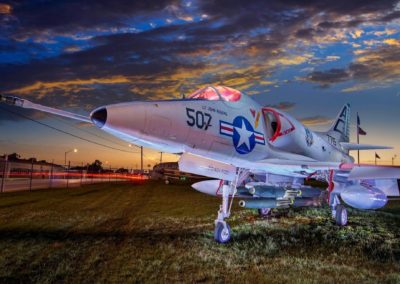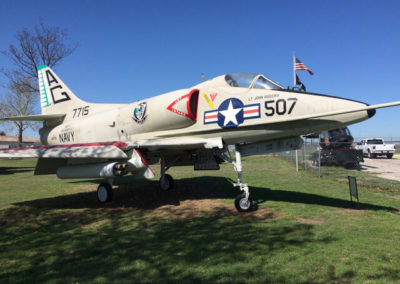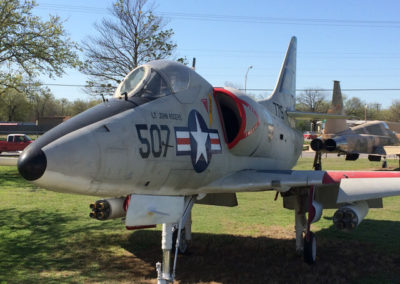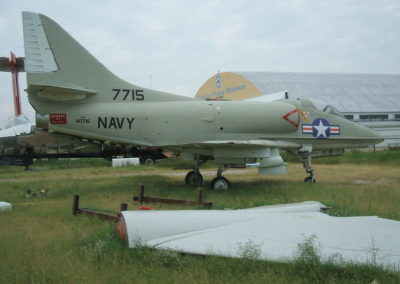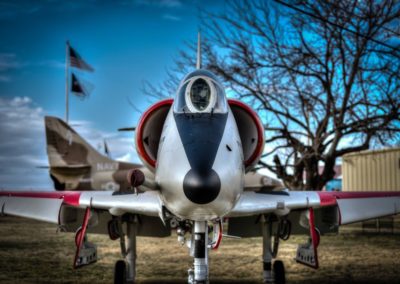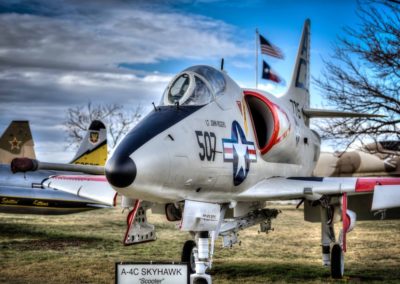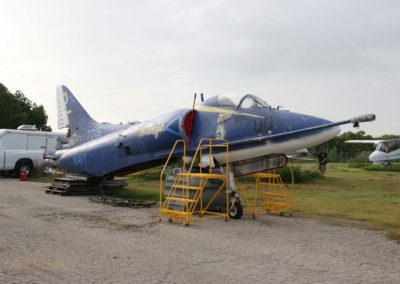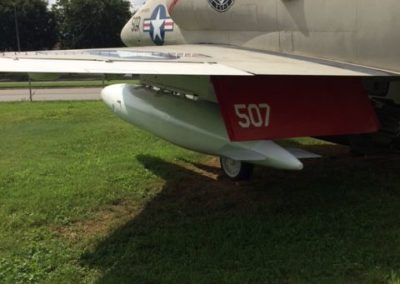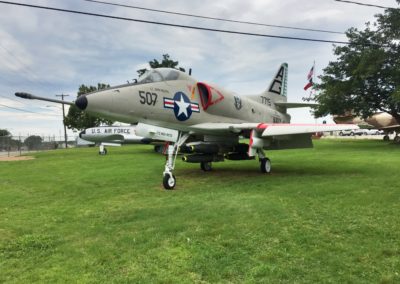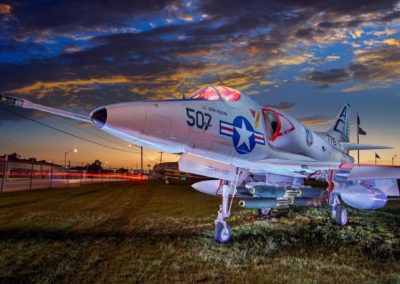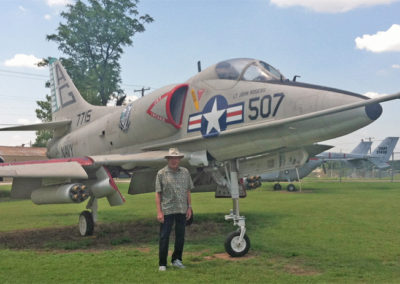A-4C Skyhawk
This plane was most recently used for ground training in Memphis and was seen there during 1975.
Warbird Overview
The Douglas A-4 was developed as a jet-powered attack aircraft to replace the propeller-driven AD or A-1 Skyraider. Once designed, the aircraft weighed only half of the Navy’s specification and it’s small wing did not have to be folded for carrier stowage. The small Skyhawk soon received nicknames like “Scooter”, “Kiddiecar”, “Bantam Bomber”, and “Tinker Toy Bomber.” Each of these was a misnomer for this powerful aircraft.
ABOUT THE A-4C SKYHAWK
The Douglas A-4 was developed as a jet-powered attack aircraft to replace the propeller-driven AD or A-1 Skyraider. Once designed, the aircraft weighed only half of the Navy’s specification and it’s small wing did not have to be folded for carrier stowage. The small Skyhawk soon received nicknames like “Scooter”, “Kiddiecar”, “Bantam Bomber”, and “Tinker Toy Bomber.” Each of these was a misnomer for this powerful aircraft.
The A-4 pioneered the concept of “buddy” air-to-air refueling allowing the aircraft to supply others of the same type, eliminating the need of dedicated tanker aircraft. The A-4 could also make an emergency landing on two drop tanks which put the aircraft out of service for a few hours.
The first prototype first flew in 1954 and deliveries began in 1956. The aircraft had a long life and remained in production until 1979, with 2,960 aircraft built, including 555 two-seat trainers. The A-4 was chosen for the Blue Angels flight demonstration team.
The A-4 was used extensively in the Vietnam War. The two-seat trainer version, the TA-4J, replaced the TF-9J Cougar until it was replaced by the T-45 Goshawk. They were retired from front line squadrons in 1978. The Marines began retiring them in the mid-1980s and were complete by 1994. The US Navy retired their last aircraft in 2003.
Fact #1
A-4’s dropped more bombs than any other aircraft in the Vietnam War.
Fact #2
The Skyhawk was the smallest aircraft capable of delivering a nuclear weapon.
Fact #3
The maximum roll rate of the Scooter was 720 degrees per second.
Manufacturer: Douglas Aircraft Company
Length: 40 feet, 3 inches
Wingspan: 26 feet, 6 inches
Height: 15 feet
Empty Weight: 10,450 pounds
Max. Takeoff Weight: 24,500 lb (11,136 kg)
Powerplant: 1 × Curtiss-Wright J65 turbojet
Max. Speed: 673 mph
Range: 1,700 nm
Rate of Climb: 8,440 ft/min
The Fort Worth Aviation Museum’s Douglas A4D-2N Skyhawk was accepted by the Navy on April 29, 1960. It carries Navy Bureau of Aeronautics Number 147715, c/n 12479, and was redesignated as an A-4C in 1962. The aircraft was assigned to Attack Squadron NINETY-THREE, VA-93, “Blue Blazers” from 09 Sep 1960 to 07 Aug 1961 at NAS Alameda, California. On 11 October 1961, the A-4 joined Attack Squadron ONE TWENTY FIVE, VA-125, “Rough Riders” at NAS Lemoore, California. On 04 Jan 1967, the aircraft was assigned to NARF at NAS Alameda, CA. On 25 Jun 1967, the aircraft joined Attack Squadron ONE TWELVE, VA-112, “Broncos”, at NAS Lemoore, CA. On 05 Oct 1967, the A-4 returned to VA-125 at NAS Lemoore.
The aircraft joined Attack Squadron EIGHT SEVENTY THREE, VA-873, at NAS Alameda, CA, on 18 May 1968, it returned to VA-125 on August 19, 1968, and then to Fleet Composite Squadron SEVEN, VC-7, at NAS Miramar on April 7, 1969, and stayed until March 1973. It was administratively stricken from the record in NAS Memphis on July 13, 1973. The plane was used for ground training in Memphis and was seen there during 1975. Although it wore Blue Angels colors, it was never a Blue Angels aircraft. In June-July 2007, the plane was disassembled by a small crew from our museum and was moved to Fort Worth. This Skyhawk is on loan from the National Naval Aviation Museum (NNAM).
Locally, A-4s of this type were operated by the US Navy in the Naval Air Reserve Unit at NAS Dallas from 1958 through 1982 for proficiency flying and air combat maneuvering (ACM) training. The A-4M was also operated by the Operations Maintenance Detachment (OMD) in an adversary role based at NAS Dallas, Texas for the Naval Air Reserve. Many of the aviators that flew the four jets were attached to NAS Dallas, including the Commanding Officer of the air station. The aircraft were instrumental in training and development of Air Combat Maneuvers (ACM) for Naval Air Reserve fighter squadrons VF-201 and VF-202 flying the F-4 Phantom II and later the Grumman F-14 Tomcat. The unit also completed several missions involving target towing to NAS Key West, Florida; NAS Kingsville, Texas, and deployments to NAS Miramar, California and NAS Fallon, Nevada for adversary support. The detachment was under the operational command of the Commander Fleet Logistics Support Wing (CFLSW), also based at NAS Dallas.
In good shape and will get it washing done to brighten up colors and bring up to date. Great example of that type, needing some touch ups and a short list of fixes here and there.
Note: Scheduling is always a moving target depending on weather and workload. All schedules are subject to changes.
Become a Member!
FLIGHT SIMULATOR
HOURS
Saturday: 9AM-2PM
Sunday: 11AM-3PM
